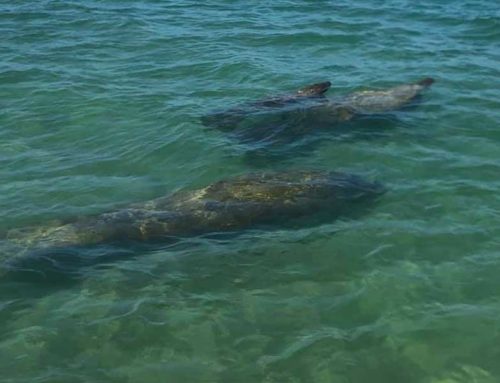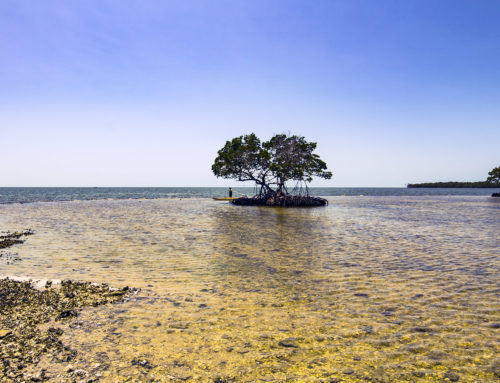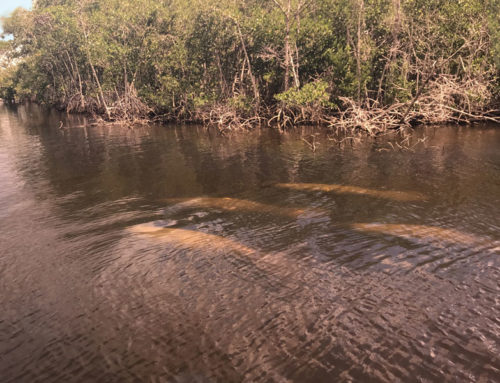Have you ever wondered how do manatees control their buoyancy when they are in the water?
Manatees use several adaptations to help control their buoyancy in the water. Although they have no swim bladder, the manatee’s heavy bones, specialized lungs, and exceptional appetite all help them with their rise and fall in the water column. Sea cows also sometimes use flatulence to help them go up and down!
How do sea cows control their buoyancy without a swim bladder?
Manatees are amazing animals and very specialized with adaptations. That being said, they are kind of the oddity in an underwater world where all the neighbors are mostly fish. Almost all bony fish have a swim bladder. A swim bladder is an organ where the fish uses gas to control its depth in the water. This allows the fish to swim without having to worry about using energy to go up and down. Now, of course, manatees are mammals and not fish so they are different. But it’s incredible to think about how they effortlessly surface and dive when they don’t even have the correct anatomy of most animals that share their environment. Manatees were probably asleep when the swim bladders were handed out. Instead, our favorite unassuming sea cows depend on many adaptations to control their buoyancy in the water.
Heavy skeletons and solid bones are factors in manatees buoyancy.
Manatees bones are incredibly heavy and dense. Most of their bones are actually solid. If you think about an elephant’s bones, that is what manatee bones are like. That makes perfect sense considering the elephants are the manatees closest relatives on earth. The ribs of sea cows are completely solid, there are no bone marrow cavities. In the manatee’s chest cavity, the sternum is the only place you’ll find bone marrow. Their ribs are very heavy and solid, which help manatees to sink. These heavy bones act a lot like a scuba divers ballast belt.
Manatees control their buoyancy with their very specialized lungs.
The lungs of the manatee may be the most interesting and specialized part of their anatomy. Sea cows are probably the animal kingdoms greatest breathers! This can be seen in the physical makeup of the lungs and the special ways in which they breathe which both influence the way they float and sink in the water.
Manatees have long, flattened lungs that run the length of their bodies. On an adult manatee, their lungs can be over 3 feet long and about 8 inches wide, but only 2 inches or less thick. Those are some big lungs! They are long, wide and thin which is pretty unique in the animal kingdom.
Incredibly when manatees breath, although they do so very quickly, they are able to exchange about 90% of the oxygen in their lungs with each breath. This is crazy – humans by comparison only replace about 10% of our oxygen with every breath. Manatees are incredible efficient breathers – no wonder they can hold their breath for up to 20 minutes!
These long thin lungs the sea cows have also help manatees to control their buoyancy. Because their lungs are positioned horizontally in their body and long, wide and skinny, it helps the manatee to remain horizontal in the water. Imagine a manatee swallowed two pool float rafts like you might use to float around in a swimming pool. That’s pretty much what sea cow lungs are like, keeping them horizontally afloat.

Manatee (Trichechus manatus latirostris) in lateral (A) and transverse (C) view, and in schematic lateral view (B), showing extreme dorsal position of lungs and the horizontal disposition of the two hemi-diaphragms, with the diaphragmatic muscle lying laterally (after Rommel and Reynolds, 2000).
Manatee diapragms
Manatees have specialized diaphragms as well, instead of one diaphragm they have two. It is called a hemidiaphragm and in essence, doubles the speed the sea cow can fill its lungs. Imagine you’re filling the air in the tires of your car. If the air hose hooked up to two tires at a time you could fill them up twice as fast. Aren’t manatees amazing?
While we are looking at the manatee’s lungs, we have to also look at the rib cage muscles and how they are used. It is another incredible manatee adaptation. The manatee is able to squeeze their lungs with their rib cage muscles. When they squeeze their lungs, it makes them denser. When their lungs are denser they sink – it’s kind of like the sea cow figured out how to have a swim bladder without having a swim bladder. Pretty cool!
The sea cow’s long, thin and shallow lungs are manipulated by their rib cage muscles. Manatees have been studied broadly for their lungs and diaphragm, as they are regarded as a key species in the evolution of the mammalian respiratory system. Squeezing the rib cage makes the manatees lungs compress and therefore their body becomes denser. The denser their lungs are, the more the manatee will sink from the added density. So in essence, the manatee’s lungs and the way they breathe makes their whole respiratory system like a big floatation device.
When manatees sleep and rest
When manatees are sleeping and resting their rib cage muscles automatically help with their buoyancy. When the manatee comes up to the surface and breathes, their lungs are filled with air. As they contract their rib muscles taking a breath, their chest is contracted, becomes denser, and they slowly descend to the bottom as a result. As they sleep or rest, the chest becomes more relaxed and expands, slowly reducing density and often helping the manatee control their buoyancy with little or even no effort. If you get the opportunity to watch a manatee sleep or rest, they can appear to be completely asleep other than the actual act of breathing. Their big, round bodies go up and down from the seabed to the surface without any movement other than the nostrils opening and closing.
The massive amount of vegetation sea cows eat helps manatees float.
Sea cows are incredible eaters. It is no exaggeration to say that manatees eat their body weight in food. Not every day, but probably about three times a month. Manatees eat on average ten to 15 percent of their body weight daily in vegetation and aquatic plants. That’s a whole lot of salad and hold the dressing.
Looking at the manatee’s digestive tract the first thing you’ll notice is that it takes up the majority of their abdomen. Yes, manatees were built to eat. Their digestive tract is huge and their intestines can reach up to about 150 feet long. They are considered a hind-gut fermenter, so although called a sea cow, they are much less like a traditional cow (fore-gut) with its multiple stomachs. They digest their food much more like a horse.
Processing all of that vegetation is tough work. Generally, it takes about a week for a manatee to ferment its seagrasses and water plants. All the fermentation creates lots of methane gas… plenty of it. Lots of manatees in captivity get names – some good names for manatees would be Bubbles or Toots… or if they were famous maybe Farty McFly, Smelly Furtado, or Gaseous Clay. Yes, manatees are very flatulent. That flatulence, believe it or not, is a key way that they alter their buoyancy.
Manatees can sink by farting.
Cute, cuddly, silly, odd and loveable, manatees are hard not to completely adore. But one of their behaviors that may not be so admirable is their tendency to fart a lot. Yes, sea cows like milk cows are adding more than their fair share of methane into the atmosphere.
It’s easy to understand how this happens considering the tremendous amount of food the manatees need to eat. This is part is because of their very slow metabolism. It’s also because of the vegetation they survive on isn’t nutritionally dense. So they do have to eat a lot to get all the nourishment that they need.
If you’ve seen manatees up close and observed them for a while, no doubt you’ve seen some bubbles nearby. Sea cows often release gas as a part of their daily routine. But, from a scientific standpoint, there is research that shows manatees can control their buoyancy from farting. They use their digestive tract and the unmistakable flatulence they exhibit as a way to rise and sink in the water.
But how does a fart make a manatee go up and down? Well, the sea cow can “hold it in” and that gas makes them a little lighter helping them to float near the surface. Or the manatee can “let it rip” releasing some gas and sink a little lower in the water.
This releasing of gas isn’t like a jetpack on their back, zooming them to the bottom. But it does help them to slowly sink lower towards the bottom.
Plus, what’s cuter than a farting manatee? Come on you know it’s true. Here’s some video proof if you don’t believe it!





Leave A Comment